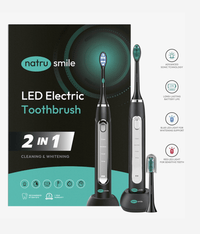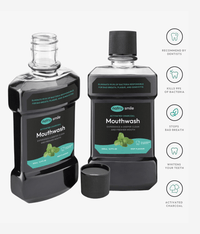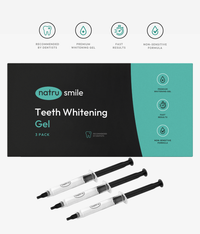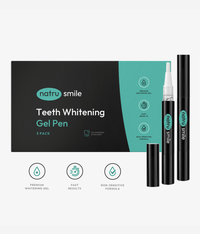
All products are certified by dental expert Dr. Greg Grillo
Have you ever looked in the mirror and noticed red dots on the roof of your mouth, leaving you scratching your head in confusion? Don't worry, you're not alone! Oral health can be a labyrinth of mysteries, and these mysterious red spots can be one of them.
But fear not, because in this comprehensive 2023 guide, we'll unravel the mysteries of those red dots with the help of a verified doctor. We'll explore the possible causes, their unique features, any accompanying symptoms, and the best treatment options available. Plus, we'll provide you with essential tips for maintaining optimal oral health.
Possible Causes Of Red Spots On Your Mouth
Many people worry that they have a health condition after seeing black spots on the tongue or a brown tongue stain, but this can often be attributed to hyperpigmentation. If the spots are red, however, this may be indicative of another problem.
Strep Throat
One of the most common causes of red spots on the roof of the mouth is strep throat. This bacterial infection is caused by the Streptococcus pyogenes bacteria and can result in red spots or patches, often accompanied by:
- A sore throat
- Fever
- Swollen glands
- Difficulty swallowing
- Red and swollen tonsils
Canker Sores
If you’ve ever Googled, “Why is there a white spot on my gums?” you may have experienced canker sores. Canker sores are small, painful ulcers that develop inside the mouth. These sores can develop on the roof of the mouth, gums, or inner cheeks. Common triggers include:
- Stress
- Hormonal fluctuations
- Food sensitivities
- Oral trauma
- Nutritional deficiencies
While they often appear as white or yellow sores, they may also manifest as red spots or bumps.
Oral Thrush
Oral thrush, a fungal infection caused by Candida yeast, can lead to red bumps or patches on the roof of the mouth. People with weakened immune systems, such as infants, the elderly, or those on certain medications, are more susceptible to oral thrush. Contributing factors include:
- Antibiotic use
- Diabetes
- Dry mouth
- Poor oral hygiene
- Denture use
Hand Foot And Mouth Disease
Hand, foot, and mouth disease is a viral infection that usually affects children under the age of 5. It is characterized by small red spots or blisters on the hands, feet, and inside the mouth, including the roof. Symptoms may include:
- Mild fever
- Loss of appetite
- Sore throat
- Fatigue
- Irritability
Physical Injury Or Trauma
Sometimes, red spots on the roof of the mouth may simply be the result of physical injury or trauma. This can occur from:
- Accidentally biting the inside of your mouth
- Eating hot or spicy foods
- Brushing your teeth too hard
- Wearing ill-fitting dentures or orthodontic appliances
- Consuming acidic foods or beverages
Keep an eye out for white spots on the teeth and even spots on the tongue, as these can also result from an injured mouth.
Coxsackievirus
Coxsackievirus infections, such as herpangina or pleurodynia, can cause red spots on the roof of the mouth, throat, and tonsils. These infections are typically accompanied by:
- Fever
- Sore throat
- Headache
- Muscle pain
- Fatigue
Oral Herpes
Oral herpes, caused by the herpes simplex virus (HSV), can manifest as red spots or blisters on the roof of the mouth, gums, or lips. These lesions are often painful and can recur throughout a person's life. Triggers for outbreaks include:
- Stress
- Sun exposure
- Hormonal changes
- Weakened immune system
- Dental procedures
Hyperdontia
In rare cases, red spots on the roof of the mouth may be indicative of hyperdontia, a condition where extra teeth develop in the mouth. These additional teeth can cause irritation and red spots in the surrounding tissue.
Hyperdontia can lead to:
- Crowding of existing teeth
- Malocclusion (misalignment of teeth)
- Impacted teeth
- Increased risk of dental decay and gum disease
Common Characteristics Of Red Spots In The Mouth
Red spots in the mouth can vary in appearance, depending on the cause. They may present as:
- Small, flat, or raised red spots
- Red patches or blisters
- Lesions surrounded by a white, yellow, or grey border
Differentiating Between Red Spots
Understanding the differences between various types of red spots can help you identify the potential cause and seek appropriate treatment. For instance:
- Red spots with a white or yellow center are likely canker sores.
- Red spots with a cluster of tiny blisters may indicate oral herpes.
- Red spots accompanied by a sore throat and fever could be a sign of strep throat or coxsackievirus infection.
Common Accompanying Symptoms Of Red Spots In The Mouth
Depending on the underlying cause, red spots in the mouth may be accompanied by:
- Sore throat
- Fever
- Swollen glands
- Difficulty swallowing
- Fatigue
- Headache
- Mouth pain or discomfort
When To Seek Medical Help
It's essential to consult a healthcare professional if you notice red spots in your mouth, especially if they are accompanied by severe pain, high fever, difficulty swallowing, or if they don't improve within one to two weeks. Proper diagnosis and treatment can help alleviate symptoms and prevent complications.
How To Treat Red Spots In Your Mouth
Antibiotics
For bacterial infections, such as strep throat, your doctor may prescribe antibiotics to help clear the infection and alleviate symptoms. These antibiotics may include penicillin or amoxicillin, and it's essential to complete the full course of treatment as prescribed.
Antifungal Medications
If oral thrush is the cause of red spots in your mouth, your healthcare provider may prescribe antifungal medications to combat the fungal infection. These medications may come in the form of lozenges, tablets, or mouthwashes, and should be used as directed for the most effective results.
Antiviral Medications
In cases of oral herpes or coxsackievirus infections, your doctor may recommend antiviral medications to help control the infection and reduce the severity and duration of symptoms. Common antiviral medications include acyclovir, valacyclovir, and famciclovir. It's important to follow your healthcare provider's instructions for optimal recovery.
Over-The-Counter Remedies
Over-the-counter pain relievers, such as ibuprofen or acetaminophen, can help reduce pain, inflammation, and fever associated with red spots in the mouth. Topical anesthetics, like benzocaine, may also provide temporary relief for mouth pain caused by canker sores or oral herpes. Some additional over-the-counter remedies include:
- Oral rinses containing hydrogen peroxide to promote healing
- Mouthwashes with antibacterial properties to help prevent infection
- Topical corticosteroids to reduce inflammation and discomfort
Diet And Lifestyle Changes
In some cases, your healthcare provider may recommend dietary and lifestyle changes to prevent further irritation or damage to the oral tissues. This can include:
- Avoiding spicy, acidic, or hard foods that may irritate the mouth
- Consuming soft, cool, and soothing foods like yogurt, ice cream, or applesauce
- Drinking plenty of water to stay hydrated and maintain a healthy oral environment
- Practicing good oral hygiene, including regular brushing and flossing
- Using a soft-bristled toothbrush to prevent further injury to the mouth
- Rinsing your mouth with a warm saltwater solution to help alleviate pain and promote healing
- Avoiding smoking and excessive alcohol consumption, as they can exacerbate oral symptoms and delay healing
Are Red Spots In The Mouth Dangerous Or Life-Threatening?
While red spots in the mouth can be uncomfortable, their danger level depends on the underlying cause. It's essential to consult a healthcare professional to determine the cause and receive appropriate treatment if necessary.
Risks And Severity
Certain underlying causes may have more severe consequences if left untreated, while others may resolve on their own with minimal discomfort.
Identifying Serious Symptoms
In some cases, red spots in the mouth may be accompanied by symptoms that warrant immediate medical attention, such as difficulty breathing or swallowing, persistent high fever, or severe pain or discomfort.
Are Red Spots On The Roof Of The Mouth Always Strep?
Red spots on the roof of the mouth can result from various causes, not just strep throat. It is crucial to consult a healthcare provider for an accurate diagnosis and appropriate treatment plan.
Diverse Causes
Some common causes of red spots on the roof of the mouth include canker sores, oral thrush, hand, foot and mouth disease, Coxsackievirus, and oral herpes.
Can Covid-19 Cause Red Spots On The Throat?
Covid-19 primarily affects the respiratory system, but it has also been linked to various oral symptoms, including red spots on the throat. It's crucial to seek medical attention if you suspect you have Covid-19.
Oral Symptoms Of Covid-19
Apart from red spots on the throat, other oral manifestations of Covid-19 may include dry mouth, loss of taste or smell, and mouth ulcers.
Are Red Spots In The Mouth Normal?
While red spots in the mouth are not considered "normal," they are relatively common and can result from various causes. Consult a healthcare professional if you notice red spots in your mouth to determine the cause and receive appropriate treatment.
Prevalence And Causes
Some potential reasons for red spots in the mouth include infections (bacterial, viral, or fungal), trauma or injury, and allergic reactions.
How Long Will The Red Spots In My Mouth Last?
The duration of red spots in the mouth depends on the underlying cause, and factors such as the individual's overall health, adherence to treatment, and effective management of underlying conditions can influence recovery time.
Duration By Cause
For instance, canker sores or oral herpes may resolve on its own within one to two weeks, while strep throat or oral thrush may require medical treatment and can improve within a few days to a week.
Are Red Spots In The Mouth An Acute Or Chronic Condition?
Red spots in the mouth can be either acute or chronic, depending on the underlying cause. Acute conditions typically appear suddenly and resolve with treatment, while chronic conditions can recur throughout a person's life.
Acute Conditions
Examples of acute conditions include strep throat, hand foot and mouth disease, and Coxsackievirus infections.
Chronic Conditions
Alternatively, red spots can be associated with chronic conditions, like oral herpes, which can recur throughout a person's life. The frequency and severity of outbreaks may decrease over time with proper management and lifestyle adjustments.
Can Red Spots In My Mouth Spread To Other Parts Of My Body?
Depending on the cause, red spots in the mouth can spread to other areas. It is essential to consult a healthcare professional for guidance on preventing the spread of red spots.
Potential For Spreading
For instance, hand foot and mouth disease can cause red spots on the hands and feet, while herpes simplex virus can cause lesions in other parts of the body, such as the genitals or eyes.
Preventing The Spread
General precautions to prevent the spread of red spots may include practicing good hygiene, avoiding close contact with affected individuals, and following prescribed treatment plans.
In Closing: Red Spots On The Roof Of Your Mouth
Red spots on the roof of the mouth can be concerning and uncomfortable.
However, it's important to remember that they can result from various causes, ranging from infections and injuries to more serious conditions. Accurate diagnosis and appropriate treatment are key to addressing these symptoms and maintaining optimal oral health.
If you notice red spots in your mouth, consult a healthcare professional to determine the underlying cause and receive the necessary guidance.
Remember to practice good oral hygiene and make any recommended dietary changes to prevent further irritation and promote healing. While red spots in the mouth can be disconcerting, with proper care and attention, they can typically be managed effectively.
Always consult your healthcare provider when experiencing symptoms or health concerns. The information provided in this guide is for educational purposes only and should not be considered a substitute for professional medical advice, diagnosis, or treatment.











